Back to Journals » Patient Preference and Adherence » Volume 17
Patients’ Perceptions on Community Pharmacy Services of a Ward (10) of Kathmandu Metropolitan
Received 19 December 2022
Accepted for publication 14 June 2023
Published 21 June 2023 Volume 2023:17 Pages 1487—1499
DOI https://doi.org/10.2147/PPA.S395774
Checked for plagiarism Yes
Review by Single anonymous peer review
Peer reviewer comments 2
Editor who approved publication: Dr Johnny Chen
Ankita Ojha, Durga Bista, Badri KC
Department of Pharmacy, Kathmandu University, Dhulikhel, Kavre, Nepal
Correspondence: Ankita Ojha, Department of Pharmacy, School of Science, Kathmandu University, Dhulikhel, Kavre, Nepal, Tel +977-9848658800, Email [email protected]
Purpose: Community pharmacists’ role is shifting from product-oriented function towards patient-centered care. The patient-centered role of pharmacists is undervalued, as the public is unaware of pharmacists’ role. This study aims to identify patients’ perceptions and satisfaction with pharmaceutical care services and factors affecting their preferences for community pharmacy services.
Patients and Methods: A quantitative cross-sectional study was conducted for three months on patients visiting registered community pharmacies in Kathmandu metropolitan ward number 10.
Results: Out of 406 participants, 30.5% perceive pharmacists to have a balance between business and health aspects of pharmacy practices; 29.1% view them as drug experts; and 11.8% consider pharmacists to be more concerned with business. 43.8% of participants were found to discuss their drug-related queries with pharmacists, possibly due to low treatment costs. Approximately 77% of respondents had no hesitancy when contacting pharmacists for health-related information because they believed pharmacists were sufficiently qualified to address drug-related questions. Around 88% of respondents agreed that the role of pharmacists is to counsel the patient about the directions for the use of medications. The level of satisfaction indicated that 72.4% are highly satisfied with pharmacy services. In addition, patients feel comfortable discussing their health with pharmacists due to their ability to protect the privacy of their medical records. In contrast, more trust in doctors seems to be the most common barrier for patients visiting pharmacists.
Conclusion: Overall, pharmacists were regarded as the most trusted health care personnel to contact. However, to facilitate the expansion of pharmaceutical care services, the public should be aware of their distinctive professional talents. It is recommended for future researchers to understand the subjective perspective of pharmacy staff, managers, and pharmaceutical policy makers.
Keywords: community pharmacy services, community pharmacist, perception, Nepal
Introduction
Globally, the health care system relies on evidence-based medicine.1 Further the health care system has evolved in the direction of patient–centeredness and acknowledging the patient’s subjective opinion.2 This trend has permeated the entire health care sector, and international organization like World Health Organization (WHO) and the International Pharmaceutical Federation (FIP) has recognized this changing scope for Pharmacy practice and promoted focus on patient-centered care.3,4 Many people in the pharmacy profession favor the shift from a product-oriented to a more patient-centered position; nevertheless, it is uncertain how the general public views this transformation.
Even though scientific interest in patients’ perspectives is new, they are beneficial in evaluating health care. Surveys and other quantitative methods have investigated pharmacy customers’ opinions of service image and quality.5 Patients need to perceive the pharmacists positively so that they can provide effective pharmaceutical services to the patient.6
According to one research conducted in Japan, the health care systems differ across countries like United Kingdom, Malaysia and Philippines due to the variation in disease between them. In Malaysia, although prescription was done by physician, the screening, dispensing is done by pharmacists along with providing medication instruction to patients. Pharmacist assistance is only allowed to support the pharmacists daily work like preparing and compounding medications for inpatient and outpatient departments, however, high-risk drugs are only dispensed by pharmacists for drug safety management.
The scenario is different in Philippines where to work as a pharmacist assistant, one does not require having a formal qualification; instead any four-year graduate is accepted. The senior pharmacy assistant is trusted by community and hospital based on their experiences. The pharmaceutical care services in community pharmacy of Cebu were efficacious as they conduct weekly fee clinic which provide the local community the free blood pressure measurement, glucose test and consultations with doctors. In Philippines there is a facility of home delivery of medicine whenever the patients are not able to walk through the community pharmacies. The medications are delivered only after checking their medication history thoroughly and confirming the prescription via phone.
In UK, pharmacists do the screening, dispensing and administration; however, labeling, preparing and compounding medicines are performed by the technicians in community pharmacies.
In Japan pharmacists need to perform the entire pharmaceutical service task since there is no pharmacy assistant to support their work like dispensing, counseling, checking medication history, etc. The pharmacists are not allowed to prescribe but they can ensure patient’s safety by cross checking their medication history by collaborating with other health professionals.7 In Nepal, community pharmacies are the first point of contact for a maximum number of patients due to their easy accessibility and no consultation fee. They are usually located in the residential area, and their service has extended from drug dispensing and counselling towards patient-centered care like monitoring blood pressure, glucose tests, checking weight etc.7
Rationale of Study
The primary focus of this study is on community pharmacy, motivated by the fact that there has been comparatively less study in community level of pharmacy setting than clinical setting while community pharmacists are only health professional who meets the patient as first point of contact. Pharmacists are attempting to improve their involvement in patient care by having a key role in improving patient safety, drug therapy management, and medication adherence. Patients need to perceive the pharmacists positively so that they could provide effective pharmaceutical services to patient.6
The main factor needed to extend the community pharmacy service is understanding what the public expects and needs from the pharmacy service. Once the knowledge and attitude of the public about community pharmacy services are known, it can assist pharmacists in meeting customers’ needs to enhance the service quality that community pharmacists could provide to improve customer satisfaction. Understanding patients’ perspectives are essential to recognize whether the public is aware of the changes in the pharmacy profession. So, this study intends to explore patients’ perspectives on community pharmacy services in a Nepali community setting, to identify how patients perceive the services from community pharmacies and evaluate it from patient's perspective.
Materials and Methods
Study Design and Participants
The cross-sectional study was conducted within registered community pharmacies in Kathmandu metropolitan ward number 10. The individuals over 18 years of age who had no difficulty communicating in English or Nepali were approached according to convenience, explained the study objectives, assured their data confidentiality, and requested to participate in the study. Those who refused consent or had physical or mental disabilities were excluded from the study.
Data Collection
Data collection took place over 3 months, from January to April 2022. The data collection process, for all participants was conducted in English. However, those who did not understand English were provided with Nepali translation. The ethical conditions and questionnaire were explained to participants after receiving consent. Finally, they were asked for their Google ID, social media account or phone number where the online built Google questionnaire form could be sent.
Questionnaire Design and Validation
The questionnaire was adapted with due permission from the author Dr. Maguy El Hajj, BScPharm, Pharm D, BCPS, who conducted a study in Qatar to assess the public’s attitudes towards the community pharmacist’s role in 2011.8 Optimal efforts were directed to translate the language in Nepali which was similar to the original English text. Assistant professor of English from Department of Management Informatics and Communication, Kathmandu University was sought prior to beginning the data collection for questionnaire language translation and validation. The pilot study was conducted within 50 participants and 34 responded with response rate of 68%.
The study contains three parts that address:
Patient’s Socio-Demographic Characteristics
Name, age, gender, religion, ethnicity, marital status, highest level of education, and occupation.
Patients’ Perception Towards Pharmacist and Factors Affecting Their Preferences for Community Pharmacy
A 6-point Likert scale was employed to measure how much patients agreed with assertions regarding community pharmacists’ multiple duties and responsibilities. The participants were assessed about the reasons for their pharmacy visit, factors which allowed them to choose the pharmacy and how often they visit community pharmacies.
Patients’ Views and Satisfaction of a Pharmaceutical Care Service at Community Pharmacy
A 6-point Likert scale was used to measure the extent to which the patients agreed with statements related to their satisfaction with community pharmacy services in Kathmandu Metropolitan ward number 10.8
Sample Size Calculation
The population size of Kathmandu Metropolitan-10 is 39,820 as per the ward office. A sample size of 396 is needed from the formula of sample size calculation below.
where, n = sample size
N = population size (39,820)
e = margin of error (5%).
Data Management and Statistical Analysis
The confidentiality of the patient was ensured while entering, handling and storing the data. Statistical package for social sciences (SPSS) version 18 (SPSS Inc., Chicago, IL, USA) and Microsoft Excel 2010 were used for data analysis and processing. Calculations for continuous data were done as means and standard deviations, while those for categorical data were done as frequencies and percentages. Five main categories of responses on a five-point Likert scale were merged (Agree, strongly agree, neutral/I do not know, disagree, strongly disagree), and mean scores and standard deviations were calculated for each statement. The data was preserved along with all associated study data in a password-protected database. Frequencies and percentages were used to assess the descriptive statistics of the questionnaire responses, which were then depicted as text, figures, and tables. Using t-tests, continuous variables were compared. Chi-square tests were used to compare categorical variables. The level of significance was set to P < 0.05.
Results
Patients’ Socio-Demographic Characteristics
Four hundred and six patients gave their consent and completed the provided questionnaire. The response rate was 58%. The socio-demographic characteristics of respondents are summarized in Table 1. The mean age was 32.71 years, S.D. = 12.69 years.
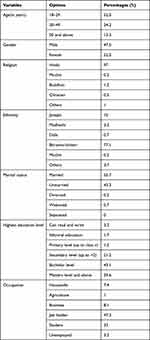 |
Table 1 Socio-Demographic Characteristics of Respondents |
Patients’ Perception Towards Pharmacist
Image of Community Pharmacists
Table 2 shows the image of patients towards community pharmacists. Most patients (30.5%) perceived community pharmacists as healthcare professionals who balance health and business matters, 29.1% view them as drug experts, while 11.8% consider pharmacists as being more concerned with business. Gender and occupation significantly correlated with how the public perceives community pharmacists (p = 0.02).
 |
Table 2 Image of Patients Towards Community Pharmacists |
43.8% of respondents said that pharmacists should be first contacted in case of drug-related issues as mentioned in Table 3. Age (p = 0.001), religion (p = 0.00), marital status (p = 0.00) and occupation (p = 0.002) is statistically significant with the first person they contact for any drug-related questions.
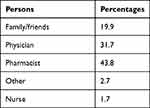 |
Table 3 First Contact Person by Respondents |
Patients’ Expectations About Community Pharmacists’ Role
Table 4 shows that patients show a high level of support for pharmacists to counsel the patient about the directions for the use of medications (88.1% agreed or strongly agreed) which has a significant association with occupation (p = 0.001). However, support dropped when it came to monitoring their health’s progress to ensure the safe and effective use of medications, which is statistically significant with the highest education level (p = 0.021). Eighty-two percent of respondents favoured that pharmacists should obtain detailed medication history, which was statistically associated with religion (p = 0.003). Similarly, 80.5% of the patients had a positive perception of pharmacists’ counselling role with significant association with education level (P = 0.004) and occupation (p = 0.004). Further, 74.4% of the participants support that pharmacists should counsel about the medicines’main side effects, their minimization and potential interactions with other medicines and this perception was significantly associated with education (p = 0.002) and occupation (p = 0.001).
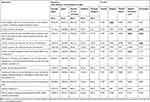 |
Table 4 Patients’expectation About Community Pharmacists’role |
Miscellaneous
Table 5 shows the most desirable quality of the pharmacist by the participants is knowledge about medications and about diseases which is cited by 70.1% of respondents where more than half percentage is cited for the quality of willingness to offer advice and to answer any drug- or disease-related queries. The most common barriers included higher trust in physicians compared with pharmacists, as shown in Figure 1. 32.8% of respondents are not aware of the ability of the pharmacists and their knowledge about drugs which prevents them from asking a question to the pharmacists. Also, 38.5% of participants have more trusts in doctors when compared to pharmacists. Maximum patients visit community pharmacy every few months (43.5%) as shown in Table 6 which is statistically significant with the highest education level (P = 0.00) and occupation (P = 0.037). According to Table 7, visiting a pharmacy for prescription and over-the-counter medicines were the two main reasons given by both 44.8% and 40.1% of respondents. Figure 2 illustrates the key elements influencing the selection of any particular pharmacy. The proximity of a pharmacy to one’s residence, place of employment, medical facility, or hospital was cited by 61.3% of respondents as the most important factor.
 |
Table 5 Patients Most Desired Qualities of Pharmacists |
 |
Table 6 Frequency of Pharmacy Visit |
 |
Table 7 Reasons for Visiting Community Pharmacies |
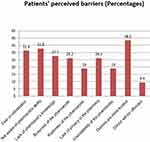 |
Figure 1 Patients’ perceived barriers for asking the question to the pharmacist. |
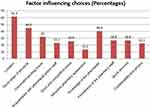 |
Figure 2 Factor influencing choice of particular pharmacy. |
Patients’ Views and Satisfaction of a Pharmaceutical Care Service at Community Pharmacy
Patients’ Extent of Agreement with the Statements
Least percentage (60.3%) of patients agreed that the pharmacist gave them enough time to discuss their problems and was always ready to answer their questions as indicated by Table 8. 77.1% of respondents agreed that they felt totally at ease about asking the pharmacist for advice which is statistically significant with religion (p = 0.05). This view about community pharmacy service is statistically significant with occupation with a p-value of 0.005. The statement that after handing the prescription, the pharmacist encourages them to ask the question and counsel them by maintaining confidentiality is supported by 69% of respondents and is statistically significant with marital status (p = 0.030) and religion (p = 0.031).
 |
Table 8 Patients’extent of Agreement with Positive Statements Regarding the Public Views of the Community Pharmacy Services |
Patients’ Current Level of Satisfaction and the Product and Services They Like to See in Community Pharmacy
According to Figure 3, more than 80% of respondents were satisfied with community pharmacy services which were statistically significant with the gender with a p value of 0.004. Figure 4 shows the services patients’ like to see provided in community pharmacies. Figure 5 illustrates the products patients’ like to see provided in community pharmacies.
 |
Figure 3 Patients’ current level of satisfaction with the community pharmacy services. |
 |
Figure 4 Services patients’ like to see provided in community pharmacies. |
 |
Figure 5 Products patients’ like to see provided in community pharmacies. |
Discussion
To make the transition of roles of pharmacists in the public’s view, community pharmacists must demonstrate the potential benefits and therapeutic outcomes of extending pharmacists’ contributions towards patient care beyond product-oriented functions such as compounding, dispensing or counselling. Pharmacists might be contacted first by some participants due to the low cost of the treatment.9 The respondents’ disagreement about pharmacists’ therapeutic role could be linked to Nepal’s early stage and insufficient development of community pharmacy services, where pharmacists are not recognised adequately as healthcare members and confront various problems to perform optimally.10 This result is also contributed by the dispensing of medicine by legally unauthorized personnel in a community pharmacy setting.11 About half of the participants visited community pharmacies to obtain prescription medication in this study, whereas this accounts for 93% of patients in the study conducted in Qatar.8 Location of the pharmacy and a good range of products and services available in the pharmacy was the primary reason to choose particular pharmacy in our study which was similar to the study conducted in Pakistan12 As has been reported in different parts of the world, the location was the main reason for using any particular pharmacy.13–15
Patients’ Views and Satisfaction of a Pharmaceutical Care Service at a Community Pharmacy
Respondents indicated a high level of trust that the pharmacist would keep their health information confidential and feel comfortable speaking with the pharmacist about their health. Our findings are inconsistent with a similar study conducted in Qatar, where only one-third of respondents agreed about pharmacists’ positive statements.16 If we are to make significant progress in therapeutic areas and create an atmosphere in which expanded scope of practice becomes standard care. Our profession must build on its current momentum by creating chances to teach and exhibit our unique talents to the public.17
Most patients were highly satisfied with the service from their community pharmacist and their general experience of visiting a pharmacy. There is evidence that patients who do not have previous exposure to new services have low expectations. According to the authors of one study, patients did not see “any scope for the pharmacist’s function beyond product supply” at first.5 The participants in the study were enthusiastic about the new community pharmacy services involving communication with the doctor in the pharmacy setting. These services are critical for the growth of pharmaceutical care in Nepal’s community pharmacies.
Conclusion and Recommendations
This study illustrates that the patients’ general attitudes regarding pharmacists and pharmaceutical services were favourable, and participants were aware of the roles and responsibilities of the pharmacists. However, some common misconceptions needed to be sorted by making the public aware of the role of pharmacists and other interventions. Although the public has a decent awareness of the pharmacist’s job, there are opportunities better to educate the public about pharmacists’ knowledge and skills. As people get more accustomed to extended services, demand for these services is expected to rise. It is believed that the success of this research will inspire many more researchers to better comprehend the subjective perspectives of not just pharmacy customers but also pharmacy staff, managers, and pharmaceutical policy makers in the future.
So further studies should incorporate details regarding the qualifications of healthcare professionals running community pharmacy services. Also, in the context of Nepal, the questions regarding the cost of medicines and irrational prescribing could be incorporated; these could be the factors influencing the choice of pharmacy service in Nepal. Future researchers are recommended to perform multi-centric studies in different urban and rural sites so that wide variety of perceptions can be used to make comparisons and the study can be generalized.
Limitations
There are certain lacking in the questionnaire regarding information related to cost of medicine and irrational prescribing as these are the probable factors patients’ considers before choosing a particular pharmacy. Moreover, due to COVID-19 pandemic face-to-face interview could not be carried out. Rather was done through online built Google questionnaire form which can lead to the respondent bias. Due to time limitation and pandemic only small urban area was approached for the study. Therefore, the study cannot be generalized to the whole metropolitan city.
Ethical Statement
Permission letter to survey Kathmandu Metropolitan ward-10 was obtained from the ward office. Before commencing the data collection, ethical clearance was provided by the Kathmandu University School of Medical Sciences – Institutional Review Committee [KUSMS-IRC] board in December 27, 2021.
Acknowledgment
The study was made possible by the guidance, support and encouragement from the faculty of Kathmandu University during each phase of this study. I would like to thank Mr. Sunil Shrestha for his valuable effort in English language editing. Further, I express my gratitude to Mr. Bipashwi Nath Uprety and Dr. Binnam Shakya of Patan Academy of Health Sciences for their guidance and suggestions throughout the study.
Disclosure
The authors report no conflicts of interest in this work.
References
1. Sackett DL, Rosenberg WMC. The need for evidence-based medicine. J R Soc Med. 1995;88(11):620–624. doi:10.1177/014107689508801105
2. Sullivan M. The new subjective medicine: taking the patient’s point of view on health care and health. Soc Sci Med. 2003;56:1595–1604. doi:10.1016/s0277-9536(02)00159-4
3. Wiedenmayer K, Summers RS, Mackie CA, Gous AGS, Everard M, Tromp D. Developing pharmacy practice– a focus on patient care handbook 2006 edition. Geneva, The Hague, The Netherlands: World Health Organization, Department of Medicine Policies and Standards, Switzerland and International Pharmaceutical Federation; 2006. Available from: https://apps.who.int/iris/handle/10665/69399.
4. Cipolle RJ, Strand LM, Morley PC. Pharmaceutical Care Practice – The Clinician’s Guide. New York: McGraw-Hill; 2004.
5. Cavaco AM, Dias JPS, Bates IP. Consumers’ perceptions of community pharmacy in Portugal: a qualitative exploratory study. Pharm World Sci. 2005;27:54–60. doi:10.1007/s11096-004-2129-z
6. Shrestha S, Poudel RS, Thapa P, Baniya S. Perception of patients towards the role of pharmacist: a cross‐sectional study from selected three hospitals in Central Nepal. JPHS. 2018;9:145–151. doi:10.1111/jphs.12217
7. Inoue Y, Takikawa M, Morita Y, Takao K, Kanamoto I, Sugibayashi K. Comparison of pharmacists’ role functions across various nations: the importance of screening. Res Social Adm Pharm. 2016;12(2):347–354. doi:10.1016/j.sapharm.2015.05.005
8. Saffouh MH, Salem S, Mansoor H. Public’s attitudes towards community pharmacy in Qatar: a pilot study. Patient Prefer Adherence. 2011;5:405–422. doi:10.2147/PPA.S22117
9. Bhuvan KC, Subish P, Mohamed Izham MI. PharmD education in Nepal: the challenges ahead. Am J Pharm Educ. 2011;75(2):38c. doi:10.5688/ajpe75238c
10. Shankar PR, Palaian S, Thapa HS, Ansari M, Regmi B. Hospital pharmacy services in teaching hospitals in Nepal: challenges and the way forward. Arch Med Health Sci. 2016;4:212–7DOI. doi:10.4103/2321-4848.196212
11. Poudel BK, Ishii I, Khakurel B. Assessment of regulatory compliance in selected pharmacy outlets of Nepal. J Pharm Health Serv Res. 2016;7:31–36. doi:10.1111/jphs.12127
12. Khan MU, Khan AN, Ahmed FR, et al. Patients’ opinion of pharmacists and their roles in health care system in Pakistan. J Young Pharma. 2013;5(3):90–94. doi:10.1016/j.jyp.2013.08.001
13. Wazaifya M, Shieldsb E, Hughesb CM, McElnayb JC. Societal perspectives on over-The-counter (OTC) medicines. Dept Biopharmaceut Clin Pharm. 2004. doi:10.1093/fampra/cmh723
14. Cordina M, McElnay JC, Hughes CM. Social perceptions of community pharmaceutical services in Malta. J Clin Pharm Ther. 1998;23:115–126. doi:10.1046/j.1365-2710.1998.00142.x
15. McElnay JC, Nicholl AJ, Rousseau GTJ. The role of the community pharmacists- a survey of public opinion in N. Ireland Int J Pharm Pract. 1993;2:95–100. doi:10.1111/j.2042-7174.1993.tb00733.x
16. Shrestha S, Shakya D, Dangol R, Danekhu K, Sharma S. Bibliometric analysis of community pharmacy research activities in Nepal over a period of 1992–2018. J Karnali Acad Health Sci. 2019;2:3. doi:10.3126/jkahs.v2i3.26663
17. Kelly D, Young S, Phillips L, Clark D. Patient attitudes regarding the role of the pharmacist and interest in expanded pharmacist services. Revue des Pharmaciens du Canada. 2014;147:239. doi:10.1177/1715163514535731
 © 2023 The Author(s). This work is published and licensed by Dove Medical Press Limited. The full terms of this license are available at https://www.dovepress.com/terms.php and incorporate the Creative Commons Attribution - Non Commercial (unported, v3.0) License.
By accessing the work you hereby accept the Terms. Non-commercial uses of the work are permitted without any further permission from Dove Medical Press Limited, provided the work is properly attributed. For permission for commercial use of this work, please see paragraphs 4.2 and 5 of our Terms.
© 2023 The Author(s). This work is published and licensed by Dove Medical Press Limited. The full terms of this license are available at https://www.dovepress.com/terms.php and incorporate the Creative Commons Attribution - Non Commercial (unported, v3.0) License.
By accessing the work you hereby accept the Terms. Non-commercial uses of the work are permitted without any further permission from Dove Medical Press Limited, provided the work is properly attributed. For permission for commercial use of this work, please see paragraphs 4.2 and 5 of our Terms.

